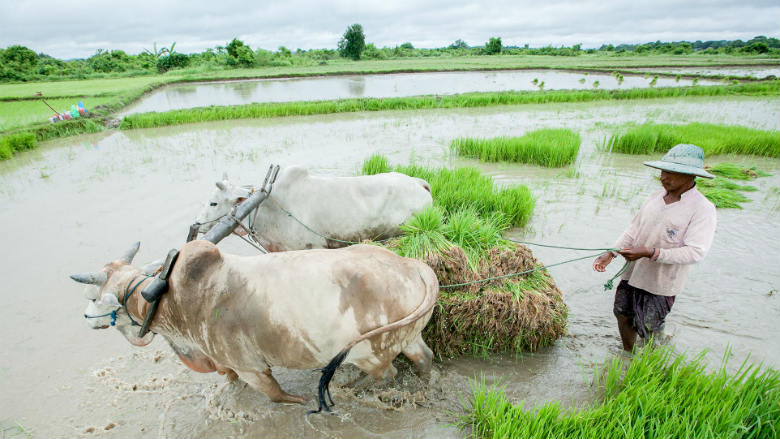Key Findings
- Myanmar’s farms are well diversified, with most farms producing rice paddy during the monsoon season and other crops such as beans, pulses, oilseeds and maize, during the cool and dry seasons.
- The study finds that agricultural productivity in Myanmar is low. For example, to harvest rice, one day of work generates only 23 kg of paddy in Myanmar, compared to 62 kg in Cambodia, 429 kg in Vietnam, and 547 kg in Thailand.
- Farm practices are still largely labor intensive. In Ayeyarwady, farmers spend more than 100 days per hectare on monsoon rice paddy compared to 52 days in Cambodia, 22 days in Vietnam, and 11 days in Thailand.
- Myanmar’s wages are still very low compared to international standards with daily wage at $2 in the Delta and Dry Zones.
- Myanmar has the lowest profits from rice production compared to those achieved by farmers in Asia’s other rice bowls. In 2013-2014, the net margin/profit from producing monsoon rice paddy averaged $114/hectare.
Low productivity is a result of multiple factors, many of them associated with the undersupply of quality public services such as research and rural infrastructure.
- Many factors affecting farm production can be influenced by the government through service delivery and an enabling policy environment.
- The public system does not produce enough good seeds and the enabling environment for the private sector is not conducive enough to stimulate seed imports or production and multiplication of seeds in the country.
- Farmers widely use urea and compound fertilizers for paddy production in both monsoon and dry seasons, but often at inefficient application rates and inappropriate nutrient compositions.
- Irrigation coverage in Myanmar is relatively low. In 2014-2015, only 15% of agricultural land was part of the public irrigation systems compared to Indonesia and Thailand (about 30%), China (about 50%), and Vietnam (70%).
Redesigning public programs can help shift the exclusive paddy production promotion to broad-based agricultural development support.
- This is vitally important as rice paddy is less profitable and more costly to produce than other crops in most agro-ecological zones, especially during the cool and dry seasons.
- Farmers with access to irrigation and working capital or loans can make good money producing dry season rice paddy. But those in drier places without access to working capital have to pick more economically suitable crops, usually pulses and oilseeds.
